Two million times each day, the “Publish” button is clicked and a blog post goes live. But we know from research that 75% of these articles get no results, or at least no traction in search or social.
We also know from research that the average post takes 3+ hours to create. Do the math and you’ll find that hundreds of millions of hours are wasted each day doing content marketing. It all adds up to 7.7 lifetimes that are wasted every day writing posts that get no results. Tragedy!
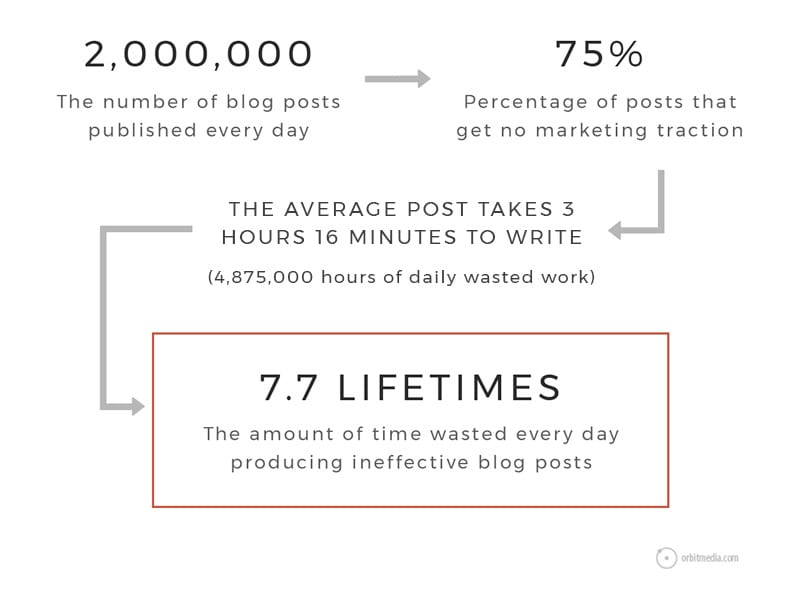
But there’s a surefire way to get huge value from your next post. It’s automatic. And it’s so efficient, we call it zero-waste marketing.
The idea is to narrow your focus and write for a very specific set of people. In this post, you’ll learn to:
- Create content for people who are already in your sales funnel
- Collaborate with your prospects and partners
- Use your blog as a networking tool
- Warm up cold leads
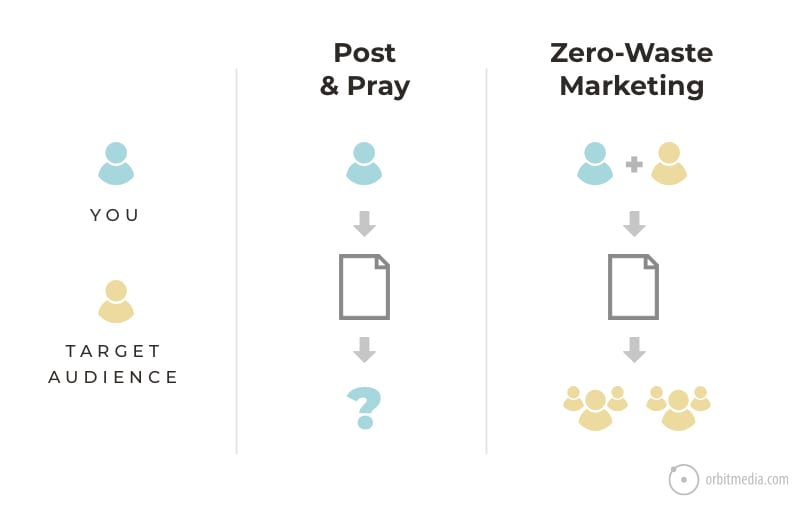
Why are we doing this? Because post and pray doesn’t work very well…
Who can use this approach?
Especially for business-to-business (B2B) companies, the sales process often involves strategic consultation. It’s an education process. And the company that shares the most expertise wins the client.
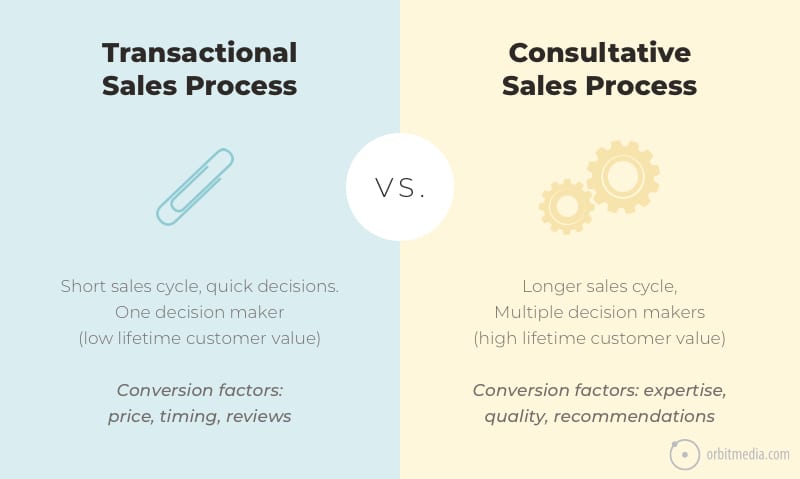
Is the psychology of sales in your industry transactional or consultative?
This approach is perfect for companies that often struggle to get results with content, including professional services firms like lawyers, accountants and architects. But really, it works for all kinds of businesses:
- Referral-driven industries where relationships are key
- Companies with small marketing teams, or solopreneurs
- Big companies trying to break down barriers between sales and marketing silos
- Non-famous brands without much content, in a hurry to get results
If this is you, you have an opportunity to create content with a laser-guided focus. You can become a thought leader in the minds that matter most.
Here are five ways to do zero-waste marketing:
1. Write Specifically for Your Current Prospects
Your next customer is your most important audience. Look at the prospects in your sales funnel, write something specifically for them, then send it to them directly.
This isn’t content for marketing. This is content for sales support.
Take a close look at the prospects in your pipeline. Do they have anything in common? What questions are they asking? What articles would support the sales conversations you’re having? Find topics that are relevant to the leads you’re already talking to.
- Write articles that answer the questions your prospects are asking (detailed how-to articles)
- Write stories or examples that address their objections or concerns (case studies)
Spend a few hours writing it up. Spend another hour editing, adding images and formatting for web content best practices. Within a day or two, you’ll be publishing a piece of laser-focused content. Now call the client and tell them you have something you’d like to share.
Example:
Your company does logistics management for the dairy industry. There are five companies considering hiring you. Three of them have big questions about how to accurately forecast demand for fresh milk across the supply chain. You’re an expert at this. You’ve explained some of it to them, but it’s not translating well through to all the decision makers.
You write a detailed 2,500-word article about how technology has changed forecasting for top dairy producers. The charts, statistics, research and examples are a clear demonstration of your expertise. You call each company personally and ask if they would be interested in taking a look…
Beyond improving your closing rate, you’ve done two things.
- You’ve created something portable. You can send it to several people at each potential client. They may even share it with each other.
- You’ve created something durable. This article will live for months or years on your site. You can send it to prospects again and again. It may also get traction in marketing.
2. Create a Series that Connects You with New Prospects
You know who your ‘A’ clients are. They check all the boxes: they appreciate your help, they can afford you and they get a ton of value from your services. The trick is connecting with them all.
Your blog is your best networking tool.
Here’s how to connect with those A-list companies. Create a format for content that puts them in the spotlight and puts you in front of them. You can interview them for a post, but you’ve got a better chance if you go big.
If you really want to impress your next prospects, upgrade the format beyond text.
- Create a podcast interview series
- Create an event that puts them on a stage
- Create a video series that features them
This works really well for production companies because the content itself showcases their talents.
Example:
Echelon Design offers high-end exhibit design and video production services. To meet local businesses and show off their talent at the same time, they created a series of videos called 12 for 12. They’re beautiful little shorts that make each company look amazing.
But the companies aren’t clients. They’re companies that Echelon wanted to meet. And the content opened the door. Those doors included Goose Island, Vosges Chocolate, intelligentsia Coffee and Second City. What brand wouldn’t want to be on this show? Content is the skeleton key that opens every door.
Check out the Vosges Chocolate episode. This is networking content at it’s best.
When you collaborate on content, you’re partnering on a project. You’re working together. It becomes easy for them to imagine working with you more.
 |
“When Adam and I set out to produce 12 For 12 all we wanted was to make something cool; something that we believed in; something that would connect us to other people. There are so many truly talented makers in the world who are building amazing brands… brands we love. These are people and companies we want to work with. So we produced a web-based docuseries. And in the process, we remade ourselves into storytellers.” – Josh Rush, Echelon Design |
3. Use Interviews to Warm Up Cold Leads
They were interested. You had a good first conversation. You learned a bit about their challenges and goals, but then you never heard back. You left a message. Then another. Now months have passed.
Time to give up and move on? Not yet!
Your next article is the perfect excuse to reach out. Don’t make another sales call. Reach out with a bit of collaborative content in mind.
Example:
Your company offers executive coaching services. You talked to several prospects last year, but the conversation died without a yes or no decision. You reach out to these cold leads with this…
“Tim, you and I talked about a project a few months back. You were considering us for a coaching engagement, but that’s not why I’m reaching out. I’m interviewing executives for a piece about leadership communication. Would you be open to being featured in this article? It would take about 20 minutes of your time.”
No one loves a sales call. But everyone loves to be interviewed.
Please, please don’t make a sales call in disguise. That’s not what I’m suggesting. But networking is about keeping in touch. Content can keep you on the radar of people who considered you in the past.
 |
“In a lengthy and complicated sales process, your key objective is to get, keep and earn ongoing attention. The process of creating content can actually keep you in front of leads. It’s a competitive advantage that improves your chances of winning (and keeping) the business.” – Matt Heinz |
4. Collaborate with referral partners and increase referral leads
About once a month, someone tells me this: “We don’t need marketing. We get all of our leads from referrals.”
Of course, it’s a crazy thing to say because marketing would add to their lead flow, but let’s set that aside for now. Here’s how to use content marketing to increase referrals by strengthening those referral relationships.
People refer leads because they met someone who needs your help …and they thought of you. So the key is to stay top of mind. Content can help.
Think about your friendly neighborhood referral partner. What do they know a lot about? What content could showcase their expertise on this topic? Got an idea for an article?
Now, reach out and ask for a quote. Add their face, name, company and link. Once it’s live, send them a nice note thanking them for their contribution. Handwritten is best.
Example:
Your company offers sales training. You sometimes get leads from HR Directors, so one of your goals is to build relationships with more of these people. HR Directors know a lot about culture and retention, so you decide to write an article on this topic in collaboration with a few potential referral partners.
“I’m writing an article about how culture affects retention. I’m including input from several experts in this area. I’m hoping you would be open to being interviewed for this article. Would you be willing to answer a few questions?”
Showcasing their expertise on your site will strengthen the relationship. And during this process, don’t be shy about reminding them what you do and who you work with. Keep the conversation going.
5. Use interviews to make connections with new potential referral partners
Content can also help create new partnerships. Just find people in non-competitive businesses who work directly with your target audience and include them in your next article.
How can you find them? Use social media to find and connect with virtually anyone you can imagine.
Example:
You’re an architect in Kansas City. If you had more relationships with interior designers, you would get more referrals. So you search Twitter for “interior design” in or near Kansas City. You find five of them.
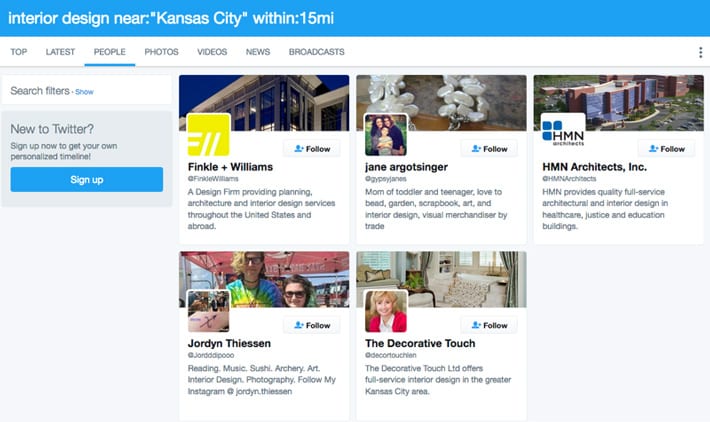
Note: You do not need to be active in social media to use this approach. You don’t even need to have a Twitter account. We’re using social media as a research tool. A phonebook.
Now we reach out to each of these people and companies. You can use email, their website contact forms or the phone. Our goal is to build a close relationship so the phone is always best.
Once we connect, ask them if they would like to be interviewed for an article you’re writing about interior design trends. You’re hoping to feature their expertise and share their insights with your audience.
Once it’s live, connect with them on LinkedIn if you’re not connected there already. Share the article there and mention them in the post.
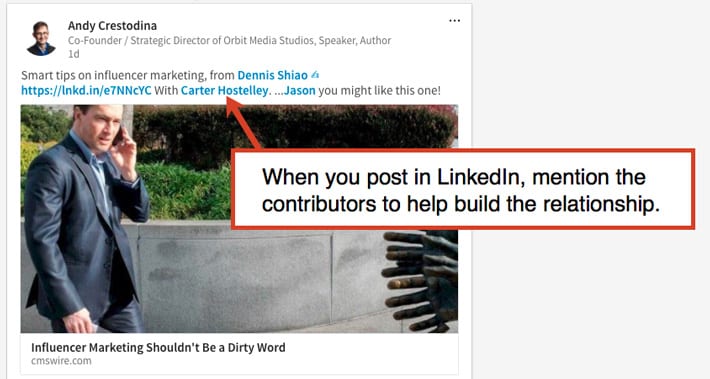
Finally, keep the conversation going. Tell them about your services, how you help people. Suggest that they keep you in mind.
Automatic success. Results even before you publish.
It’s lovely to rank, to get shared and to get visitors. But there is more to life than traffic. A few strong relationships can be far more important than numbers in your Analytics. And sales are better than marketing.
So use your content as a networking tool. Do some collaborative content marketing. When networking is the goal, success is automatic. Results are guaranteed.




